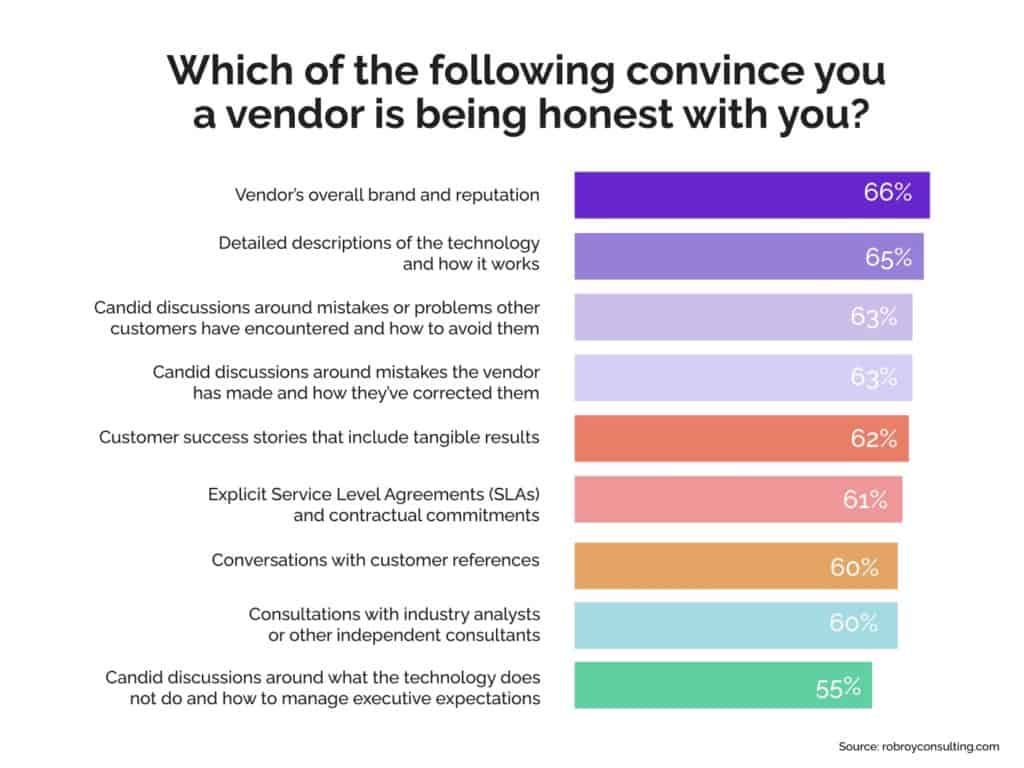Trust remains an issue for tech buyers. When asked to what extent they feel technology vendors are being honest with them, 73% believed that most tech vendors fell short of the mark, according to a survey performed by Cambia Information Group.
While, at first glance, it looks like there’s a trust crisis, the reality is that B2B vendors face a new normal: an undercurrent of skepticism built up over years of hype. So, what do buyers care about above all else in 2023? The simple answer is word-of-mouth.
Translation: The burden of proof is on B2B tech vendors to prove they’re trustworthy. But how can you build trust in such a skeptical environment?
Positive word-of-mouth
The same techniques that have earned buyers’ trust over the years remain. Talk about mistakes and lessons learned; talk about successes and results. Each strategy offers differentiated and equally effective pathways to earning the trust of buyers.

But they aren’t the only thing impacting trust in B2B brands.
Vision and values impact the trust that B2B tech buyers have in vendors, not just value propositions. While 91% say a vendor’s vision, mission, or purpose impacts their purchase decision, 80% say that how vendors respond to issues such as racial equality, diversity and inclusion, and social justice also impacts their decision.
So how do you differentiate between the buyers’ varied priorities?
Winning the Business
When it comes to actually winning the business, there is a lot for buyers to consider. For starters, when they’re thinking about a large technology purchase for their company, they may check:
- Social media (39%)
- The company website (58%)
- Industry analyst reports (67%)
- Technology publications (67%)
Or, like 73% of respondents in Cambria Information Group’s 625-person study, they may chat with their peers.
As is obviously shown by these numbers, when it comes to closing the deal, word-of-mouth from peers is still the #1 source of influence. And this makes sense since relationships are the most important part of trust-building.
The truth is, B2B tech buyers trust the people they have relationships with more than they trust your website, social media activity, or your salespeople. And outside of peers, they trust others who have already purchased and used your products or services. That’s why sales collateral is so valuable—because it amplifies the voices of those who have already converted. Your company offers your existing customers to join your referral program and then do referral tracking to make informed decisions and improve your program.
Related reading: Why Your B2B Marketing Strategy Needs Sales Collateral – Zen Media
The tricky element in all of this is that the most impactful messaging isn’t within your control. It’s your customers who will have the largest impact on your prospects’ trust.
One of the first things consumers search for is reviews. If a website only ranks your company 2 out of 5, for example, it’s likely the buyer won’t even bother researching your company any further. They’ll move on to 3-star+ competitors.
In order to win over B2B tech buyers in 2023, you have to make sure all avenues where you can impact word-of-mouth are up-to-date. Are all of your Google reviews at 4 stars or higher? Have you responded to the lower-star reviews to ask how you can improve their experience? Have you checked your reviews on Glassdoor, Yelp, and Facebook (if applicable)?
Word-of-Mouth Reshapes Business Priorities
Word-of-mouth is not only critical to drawing in new prospects and converting them; it can even impact overarching business and budget priorities—70% say it reshapes their business priorities and influences budget allocation.
And it’s not just about online reviews. Word-of-mouth is often just that—verbal.
So how do you get your clients to say good things about you and your services? Make sure your customers are happy.
Do you check in with them after the point of sale to make sure they got what they needed? Do you check in on a regular basis to see if any of their needs aren’t being met? B2B email campaigns are a great way to not only ensure that customers are seeing what you’re up to, but that they remember to talk about you when someone asks them for a referral.
Using content to generate word-of-mouth
Reframing tech and business challenges and challenging preconceptions are still the best content marketing tactics for generating word-of-mouth. It all boils down to this: 71% say the content provides a helpful new way to approach a relevant technology challenge.
So how are you producing content? Whether it’s via a subject-matter expert—an influencer in the field or a c-suite executive on your team—or posting regular content on a company blog, you want your potential customers to know that you know what you’re talking about. And that brings us to our next topic.
Related reading: How Subject Matter Experts Can Help Build Your Brand – Zen Media
Shaping Perceptions about Technology Trends
In addition to driving sales, it’s useful to shape the way customers think about overall technology trends. A great way to do that is via the internal B2B content your company produces. A multi-channel approach is critical because customers consult multiple sources of information (five, on average) when looking for information about technology. And the ones they turn to first are tech trades (68%), analyst reports (61%), and company websites (58%).
While your blog likely won’t be on the front page of tech trades or analyst reports, having a strong PR campaign is a great way to get it in the right hands. Are you pitching your content to these sources? Do all the right people know the latest news about your company?
Related reading: Public Relations for B2B Tech Companies: In-house or Outsource? – Zen Media
Staying top-of-mind
The goal here is to stay top-of-mind for potential buyers. Customers like to stay educated on key issues and innovations in their sector, and when surveyed, they said they check in a few times per week or more. In other words: You want to stay top-of-mind when your potential customers are researching their next B2B tech purchase. The most effective channels are search engines, conversations with peers, and social media, in this case.
Related reading:
Whatever story you decide to tell about your business, make sure it’s one you believe in. Conviction convinces. But the burden of proof is on you to prove that your company is trustworthy. Be sure to talk about lessons learned, challenge hype, and be open about the limitations of technology.
Customers rely on multiple sources of information. Make sure your story is omnichannel and consistent. And don’t forget to include your vision, mission, and values when telling your story. Once you prioritize driving word of mouth, it will influence new leads, closing deals, and business priorities.
Do you have your word-of-mouth strategy fleshed out? Are you getting in all the right publications? If you’d like some help, reach out!





